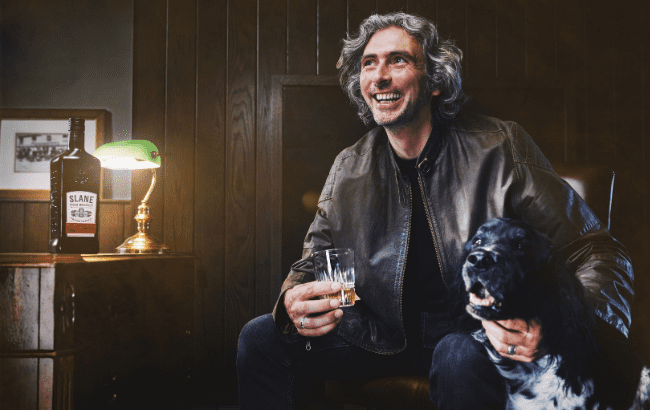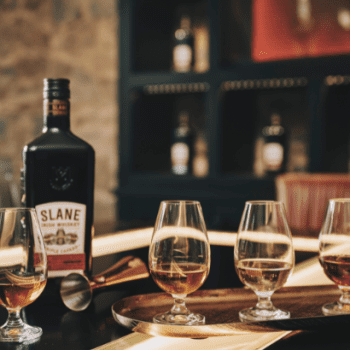My shopping cart
Your cart is currently empty.
Continue ShoppingJoin us on Monday November 11th for lunch and stay to meet the co-founder of Slane Irish Whiskey and part of the ancestral family of Slane Castle. Enjoy a complimentary tasting of one of the fastest growing Irish Whiskey brands while getting to meet and hear Alex's story. Slane Irish Whiskey will be available for purchase and can be signed by Alex. He will arrive at Clock Restoration between 2:30 and 3pm and will be staying till 4pm. Hoping to see any Veterans on this Veteran's Day, QG Members, Clock regulars and members of local Irish societies.
Below is an article from "The Spirit Business" sharing his story and his whiskey philosophy.
The co-founder of Irish distillery Slane, located on the grounds of a historic castle, on why he focuses on flavor over age statements.
.

.
The co-founder of Slane Irish whiskey, Alex Conyngham, had a rather unique upbringing. He grew up in Slane Castle, which has been the ancestral home of his family since the early 1700s, located on the edge of its namesake village in Ireland.
Today, it is more popularly known for hosting music festivals on its grounds, with concerts from the likes of U2, Bob Dylan, Bruce Springsteen, Queen, Foo Fighters, Red Hot Chilli Peppers, and more recently, Harry Styles.
Conyngham says the castle was “saved by rock and roll” in 1981 when his father, Henry Conyngham, was forced to look at ways to continue its upkeep. He had the idea of using the castle as the setting for Slane’s first gig, featuring Thin Lizzy.
Decades later, Alex Conyngham had a dream to launch his own Irish whiskey under the Slane name, after gaining experience in the industry as a brand ambassador for Jameson.
Slane Irish Whiskey was created in collaboration with another family-owned business, US drinks firm Brown-Forman (the company behind Jack Daniel’s). The distillery’s construction was completed in 2017 and whiskey production began a year later.
Since Brown-Forman’s acquisition of the Irish whiskey maker in 2015, the States has become the leading market for Slane.
“We’re in every state there, [Brown-Forman’s] route to market was really important for us. We’re in France, Germany, Czechia, the UK, Australia, New Zealand and then obviously global travel retail,” says Conyngham.
“We’ve only really touched the tip of the iceberg. I would like to see us expand more heavily into Europe; I think there are some very exciting opportunities in emerging markets. If you look at Africa as a continent, I think it’s a huge opportunity. And then Asia, in markets like Vietnam and others [but] we’re not really doing anything in those.
“I think we were waiting until we were consistently and confidently producing a product, being our core blend, and I think we’ve done that now.”

He hopes that geographical expansion will be “notched up” in the next two to three years.
“There are markets where Brown-Forman has taken a stronger role in its own distribution, and these would obviously be opportunities for us to go after,” he adds, citing the likes of South America, East Africa and Southern Africa. He also highlighted Nigeria, which soared by 59% in Irish whiskey exports last year (according to a Bord Bia report).
Slane’s whiskey production is in the safe hands of Dr Gearóid Cahill, who became its first master distiller in February 2022. The distillery produces its flagship Triple Casked whiskey (40% ABV), a Batch Strength release (61%-63% ABV) and a global travel retail-exclusive expression called Slane Extra Sherry Wood (45% ABV).
Future innovation
The company is planning to release a single grain whiskey and single malt in the next two to three years.
Conyngham believes the single grain will be unlike anything else in the Irish whiskey category due to its very high percentage of unmalted barley at around 80%.
“This means that our new make grain would have a really surprisingly sort of soft mouthfeel, which is what you’d expect from your malted barley, and then this lovely, kind of natural spice, so it’s kind of creamy and spicy, and it’s got a lot of character, and I think that’s performing really well in the wood.”
As it builds distribution for its core whiskey and plans new releases, the distillery is also looking at other ways to innovate in its production.
“Now we’re at the point where I think we have the confidence to maybe start flexing a little bit in terms of what other variables in the process can we start to change in order to deepen our point of difference and our own identity,” Conyngham says.
“Whatever we do, any tweaking must always have a positive impact on flavour. So if that means, for example, looking at what we might be doing with our yeast. Gearóid’s doctorate is in yeast, so that might be a natural area for us to start exploring. It makes sense because it’s going to have a direct impact on flavour.”
Brown-Forman already cultivates its own yeast at some of its other sites, Conyngham highlights.
Conyngham has been involved in farming for many years, particularly organic practices, and manages nearby Rock Farm with his wife Carina Conyngham, growing the barley that is now used at Slane Distillery. All of the unmalted barley for pot still and grain whiskey production is sourced from the estate itself.
Slane also has the ability to produce single-estate whiskeys due to its vast amount of land with 1,500 acres, he adds. The company doesn’t currently malt, bottle or mature its liquid on site, but Conyngham hasn’t ruled out incorporating malting and maturation in the future.
He is also keen to explore what the company can do with grain or cereal cultivation to differentiate the producer from others and make a “positive impact on flavor”.

One example would be an exploration of heritage barley strains and how they can produce different flavour profiles, while supporting biodiversity.
He says there would be “potential beneficial effects on biodiversity because longer straw varieties support life that has been pushed out of farms through shorter straw varieties, field mice, corn crates, etc”.
The company is growing Irish oak on its estate, which will take 50 to 100 years to grow.
“I would like to see us doing something with native wood here,” Conyngham explains, adding that it would “help us to deepen our single-estate notion if we were able to take a whiskey that was made from cereals grown ourselves, distilled and matured on the property from a cask made from wood on the estate”.
Slane also has a long-term ambition to become a zero-waste distillery, with energy recovery and reduced water consumption incorporated into its design.
Age statements: ‘misleading and constrained’
On the topic of age statements in the whiskey industry, Conyngham believes they can be “misleading” and the focus should be on quality.
“What perhaps is more interesting – and I’m not saying this is necessarily something we will do – but if you look at the climatic conditions in years, a bit like in wine, no two harvests are the same,” he says. “And although there’s much less variation in cereals than there would be in grapes, they do still vary.
“Protein contents are different depending on the microorganisms and the soil, and the whole notion of terroir. When it comes to maturation, I find with age statements, there is definitely a constraint in terms of inventory management. Because you have to base the age statement on the youngest liquid in the bottle, it doesn’t necessarily reveal that there’s perhaps liquid in there that’s older.”
He stresses the importance of the quality of a barrel and what it imparts. “You could spend six years in a knockout, incredible barrel, or spend 10 years in one that just doesn’t deliver as positive a flavour impact. And that’s why I find age statements are maybe a little misleading and constrained.
“I would rather deliver really, really good flavour. And although age is one component, I don’t think it should be the flag on which you pin your identity. Now I’m only one voice in the room, so we may see an age statement from Slane in the future. But regardless of that, I will always be focusing on quality over age.”
The future of Slane will “lean deeper into flavor” and focus on “delivering a great core product consistently” as it expands internationally.
“Perhaps in the next 10 to 20 years, we’re then going to have a range of ultra-premium offerings that are very much rooted in our sense of place,” says Conyngham. “So I almost see us as kind of taking a bit of a wine approach to the whiskey category, where you would have a much closer relationship between the distillery site and the land around it.”